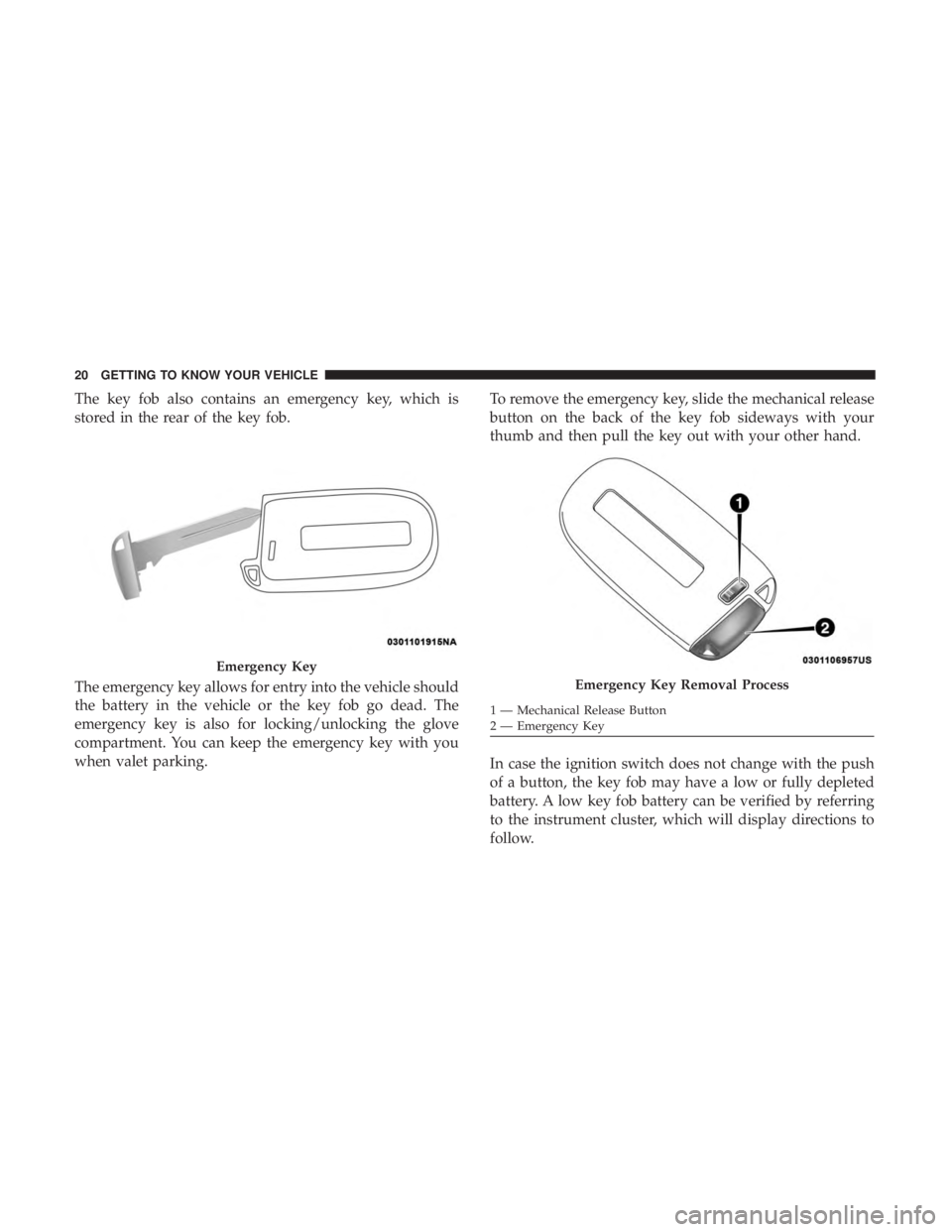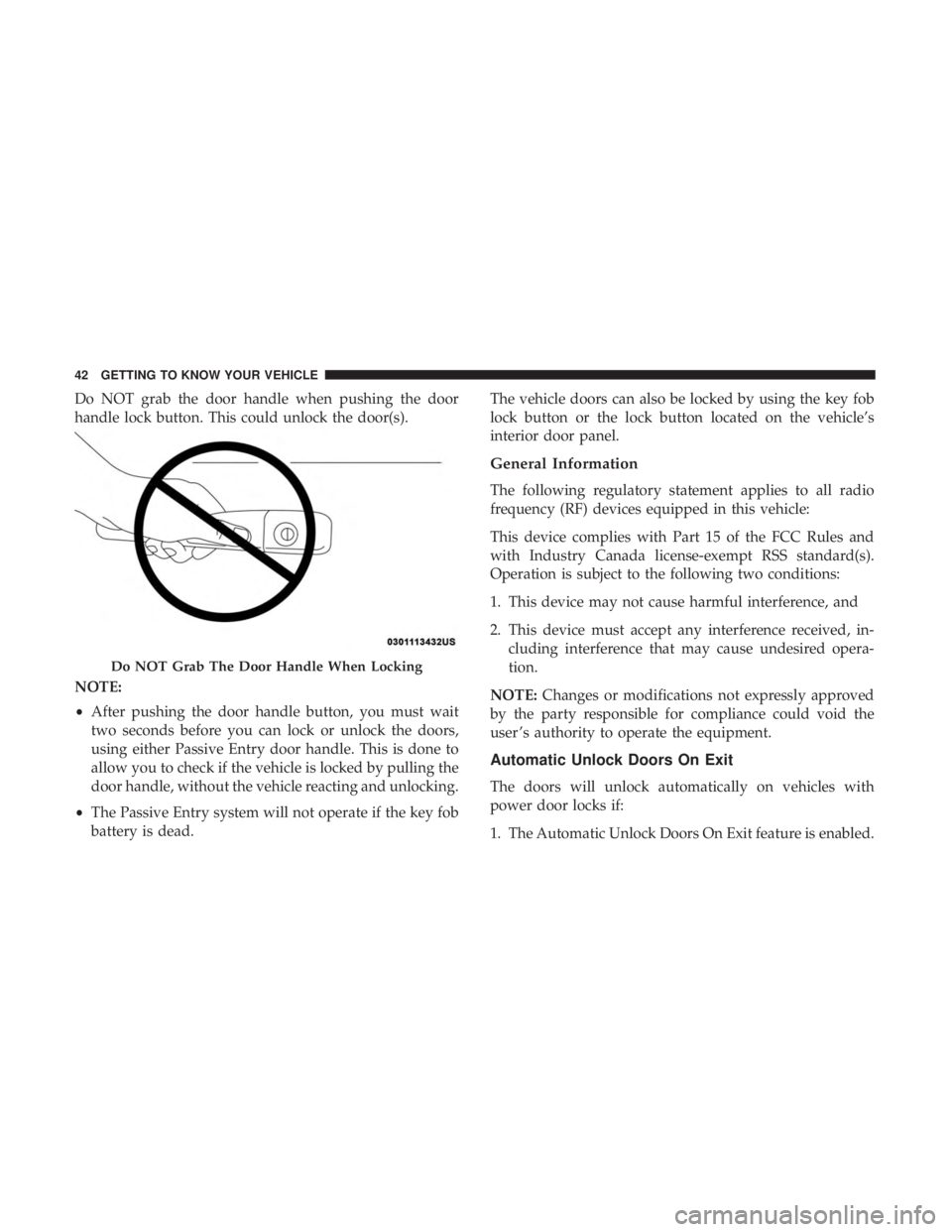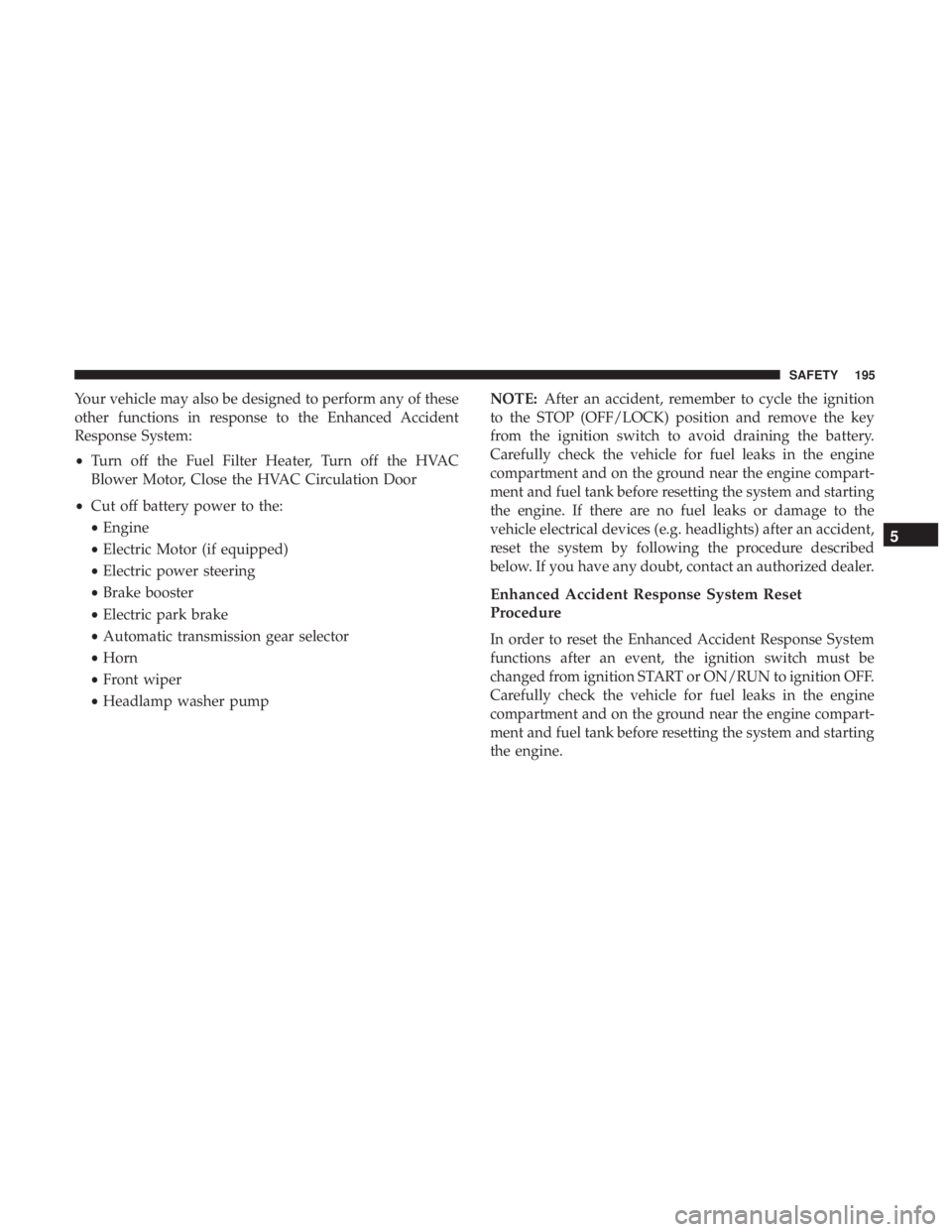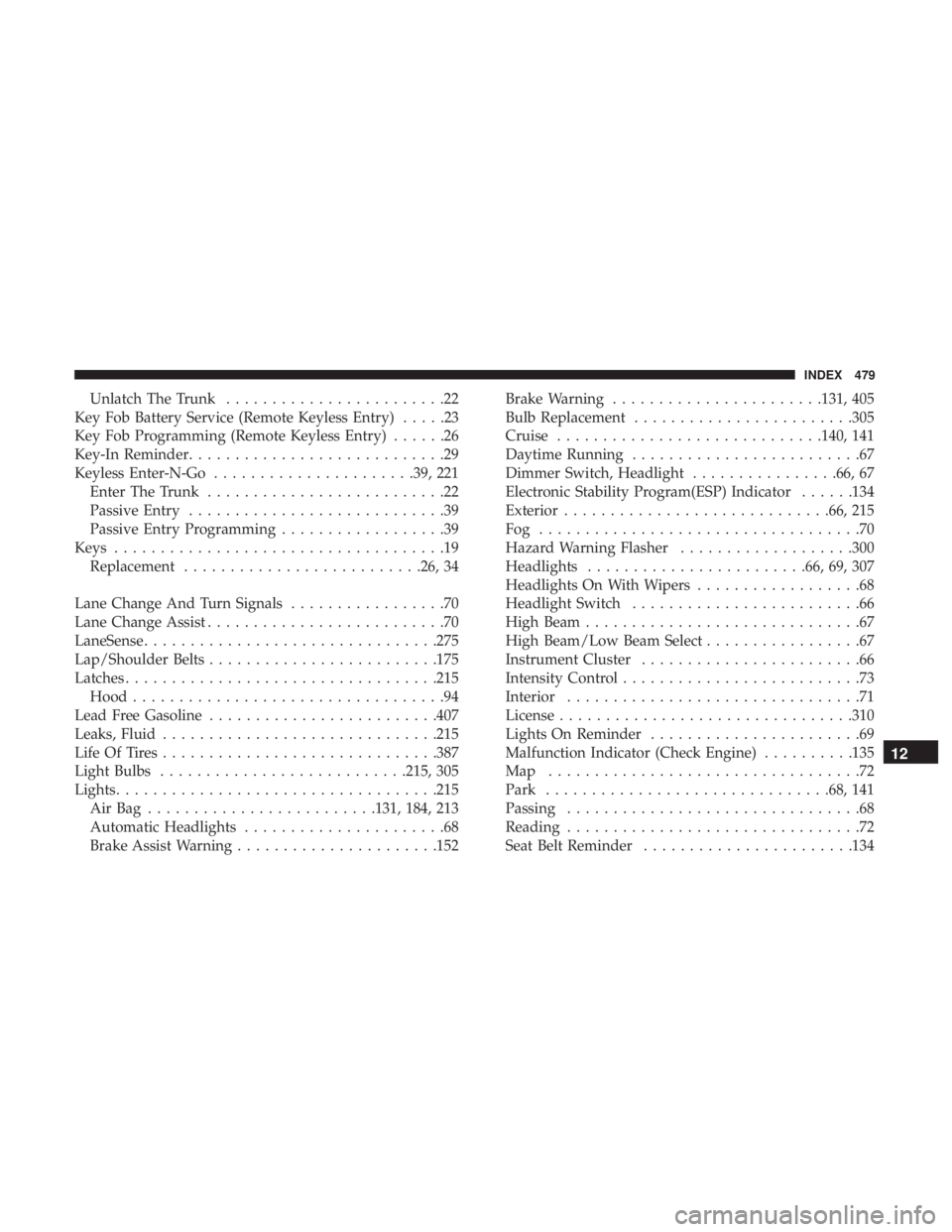2019 CHRYSLER 300 change key battery
[x] Cancel search: change key batteryPage 22 of 492

The key fob also contains an emergency key, which is
stored in the rear of the key fob.
The emergency key allows for entry into the vehicle should
the battery in the vehicle or the key fob go dead. The
emergency key is also for locking/unlocking the glove
compartment. You can keep the emergency key with you
when valet parking.To remove the emergency key, slide the mechanical release
button on the back of the key fob sideways with your
thumb and then pull the key out with your other hand.
In case the ignition switch does not change with the push
of a button, the key fob may have a low or fully depleted
battery. A low key fob battery can be verified by referring
to the instrument cluster, which will display directions to
follow.
Emergency Key
Emergency Key Removal Process
1 — Mechanical Release Button
2 — Emergency Key
20 GETTING TO KNOW YOUR VEHICLE
Page 23 of 492

NOTE:In a situation of a low or fully depleted battery, a
backup method can be used to operate the ignition switch.
Put the nose side of the key fob (side opposite of the
Emergency Key) against the ENGINE START/STOP button
and push to operate the ignition switch.
To Unlock The Doors
Push and release the unlock button on the key fob once to
unlock the driver’s door or twice within five seconds to
unlock all doors.
The turn signal lights will flash to acknowledge the unlock
signal. The illuminated entry system will also be activated.
NOTE: All door unlock settings can be programmed to
your convenience through Uconnect Settings. Refer to
“Uconnect Settings” in “Multimedia” for further informa-
tion.
• Unlock the driver door on the first push of the key fob
unlock button.
• Unlock all doors on the first push of the key fob unlock
button. NOTE:
To unlock doors and trunk with passive entry, refer
to “Keyless Enter-N-Go — Passive Entry” located in
“Doors” in “Getting To Know Your Vehicle” for further
information.
NOTE: When you use the key fob to open any door, the
courtesy lights, overhead lights, and approach lighting in
the outside mirrors (if equipped) will turn on. Refer to
“Interior Lights” in “Getting To Know Your Vehicle” for
further information.
1st Press Of Key Fob Unlocks
This feature lets you program the system to unlock either
the driver’s door or all doors on the first push of the unlock
button on the key fob.
To change the current setting, refer to “Uconnect Settings”
in “Multimedia” for further information.
Flash Lights With Lock
This feature will cause the turn signal lights to flash when
the doors are locked with the key fob. This feature can be
turned on or turned off. To change the current setting, refer
to “Uconnect Settings” in “Multimedia” for further infor-
mation.
3
GETTING TO KNOW YOUR VEHICLE 21
Page 29 of 492

Duplication of key fobs may be performed at an authorized
dealer. This procedure consists of programming a blank
key fob to the vehicle electronics. A blank key fob is one
that has never been programmed.
NOTE:When having the Sentry Key Immobilizer System
serviced, bring all vehicle keys with you to an authorized
dealer.
General Information
The following regulatory statement applies to all radio
frequency (RF) devices equipped in this vehicle:
This device complies with Part 15 of the FCC Rules and
with Industry Canada license-exempt RSS standard(s).
Operation is subject to the following two conditions:
1. This device may not cause harmful interference, and
2. This device must accept any interference received, in- cluding interference that may cause undesired opera-
tion.
NOTE: Changes or modifications not expressly approved
by the party responsible for compliance could void the
user ’s authority to operate the equipment.
IGNITION SWITCH
Keyless Push Button Ignition
This feature allows the driver to operate the ignition with
the push of a button as long as the key fob is in the
passenger compartment.
The Keyless Push Button Ignition has four operating
positions, three of which are labeled and will illuminate
when in position. The three positions are OFF, ACC, and
ON/RUN. The fourth position is START. During start,
ON/RUN will illuminate.
NOTE: If the ignition switch does not change with the
push of a button, the key fob may have a low or dead
battery. In this situation, a back up method can be used to
operate the ignition switch. Put the nose side (side opposite
of the emergency key) of the key fob against the ENGINE
START/STOP button and push to operate the ignition
switch.
3
GETTING TO KNOW YOUR VEHICLE 27
Page 44 of 492

Do NOT grab the door handle when pushing the door
handle lock button. This could unlock the door(s).
NOTE:
•After pushing the door handle button, you must wait
two seconds before you can lock or unlock the doors,
using either Passive Entry door handle. This is done to
allow you to check if the vehicle is locked by pulling the
door handle, without the vehicle reacting and unlocking.
• The Passive Entry system will not operate if the key fob
battery is dead. The vehicle doors can also be locked by using the key fob
lock button or the lock button located on the vehicle’s
interior door panel.
General Information
The following regulatory statement applies to all radio
frequency (RF) devices equipped in this vehicle:
This device complies with Part 15 of the FCC Rules and
with Industry Canada license-exempt RSS standard(s).
Operation is subject to the following two conditions:
1. This device may not cause harmful interference, and
2. This device must accept any interference received, in-
cluding interference that may cause undesired opera-
tion.
NOTE: Changes or modifications not expressly approved
by the party responsible for compliance could void the
user ’s authority to operate the equipment.
Automatic Unlock Doors On Exit
The doors will unlock automatically on vehicles with
power door locks if:
1. The Automatic Unlock Doors On Exit feature is enabled.
Do NOT Grab The Door Handle When Locking
42 GETTING TO KNOW YOUR VEHICLE
Page 197 of 492

Your vehicle may also be designed to perform any of these
other functions in response to the Enhanced Accident
Response System:
•Turn off the Fuel Filter Heater, Turn off the HVAC
Blower Motor, Close the HVAC Circulation Door
• Cut off battery power to the:
• Engine
• Electric Motor (if equipped)
• Electric power steering
• Brake booster
• Electric park brake
• Automatic transmission gear selector
• Horn
• Front wiper
• Headlamp washer pump NOTE:
After an accident, remember to cycle the ignition
to the STOP (OFF/LOCK) position and remove the key
from the ignition switch to avoid draining the battery.
Carefully check the vehicle for fuel leaks in the engine
compartment and on the ground near the engine compart-
ment and fuel tank before resetting the system and starting
the engine. If there are no fuel leaks or damage to the
vehicle electrical devices (e.g. headlights) after an accident,
reset the system by following the procedure described
below. If you have any doubt, contact an authorized dealer.
Enhanced Accident Response System Reset
Procedure
In order to reset the Enhanced Accident Response System
functions after an event, the ignition switch must be
changed from ignition START or ON/RUN to ignition OFF.
Carefully check the vehicle for fuel leaks in the engine
compartment and on the ground near the engine compart-
ment and fuel tank before resetting the system and starting
the engine.
5
SAFETY 195
Page 475 of 492

Anti-Lock Brake System (ABS).................146
Anti-Lock Warning Light .....................139
Apple CarPlay ........................... .462
Arming System Security Alarm ...........................35
Assist, Hill Start .......................... .153
Audio Systems (Radio) ...................... .421
Auto Down Power Windows ...................88
Automatic Door Locks .....................42, 43
Automatic Headlights ........................68
Automatic High Beams .......................67
Automatic Temperature Control (ATC) ............84
Automatic Transmission ..................... .230
Adding Fluid .....................372, 415, 417
Fluid And Filter Change ...................372
Fluid Change .......................... .372
Fluid Level Check ....................... .371
Fluid Type ...................... .371, 415, 417
Special Additives ........................ .371
Automatic Transmission Limp Home Mode .....42, 236
Autostick Operation ............................. .237
Auto Up Power Windows .....................88
AUXCord .............................. .447
Auxiliary Electrical Outlet (Power Outlet) .........113AW D
Towing ............................... .338
Axle Fluid ........................... .415, 417
Axle Lubrication ....................... .415, 417
Back-Up ................................ .279
Battery .............................. .133, 351
Charging System Light ....................133
Keyless Key Fob Replacement ................23
Location .............................. .351
Belts, Seat ............................... .213
Beverage Holder Cooled (Cupholder) ............111
Beverage Holder Heated (Cupholder) ............111
Body Mechanism Lubrication ..................359
B-Pillar Location .......................... .379
Brake Assist System ........................ .147
Brake
Control System ....................... .147
Brake Fluid ....................... .369, 415, 417
Brake System ......................... .369, 405
Fluid Check ..................... .369, 415, 417
Master Cylinder ........................ .369
Parking .............................. .226
Warning Light ...................... .131, 405
Brake/Transmission Interlock ..................230
Break-In Recommendations, New Vehicle ..........225
12
INDEX 473
Page 481 of 492

Unlatch The Trunk........................22
Key Fob Battery Service (Remote Keyless Entry) .....23
Key Fob Programming (Remote Keyless Entry) ......26
Key-In Reminder ............................29
Keyless Enter-N-Go ..................... .39, 221
Enter The Trunk ..........................22
Passive Entry ............................39
Passive Entry Programming ..................39
Keys ....................................19
Replacement ......................... .26, 34
Lane Change And Turn Signals .................70
Lane Change Assist ..........................70
LaneSense ............................... .275
Lap/Shoulder Belts ........................ .175
Latches ................................. .215
Hood ..................................94
Lead Free Gasoline ........................ .407
Leaks, Fluid ............................. .215
Life Of Tires ............................. .387
Light Bulbs .......................... .215, 305
Lights .................................. .215
AirBag .........................131, 184, 213
Automatic Headlights ......................68
Brake Assist Warning ..................... .152Brake Warning
...................... .131, 405
Bulb Replacement ....................... .305
Cruise ............................ .140, 141
Daytime Running .........................67
Dimmer Switch, Headlight ................66, 67
Electronic Stability Program(ESP) Indicator ......134
Exterior ............................ .66, 215
Fog ...................................70
Hazard Warning Flasher ...................300
Headlights ....................... .66, 69, 307
Headlights On With Wipers ..................68
Headlight Switch .........................66
High Beam ..............................67
High Beam/Low Beam Select .................67
Instrument Cluster ........................66
Intensity Control ..........................73
Interior ................................71
License ............................... .310
Lights
On Reminder .......................69
Malfunction Indicator (Check Engine) ..........135
Map ..................................72
Park .............................. .68, 141
Passing ................................68
Reading ................................72
Seat Belt Reminder ...................... .134
12
INDEX 479